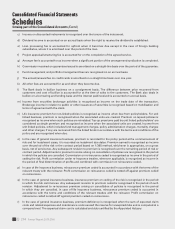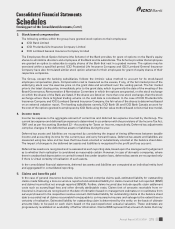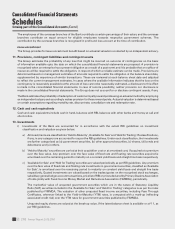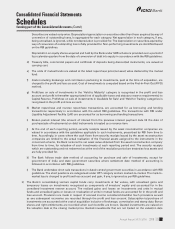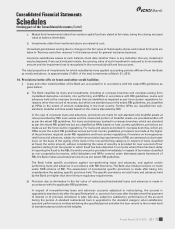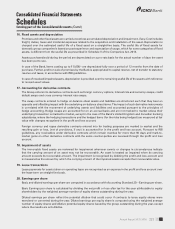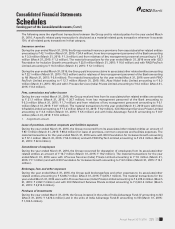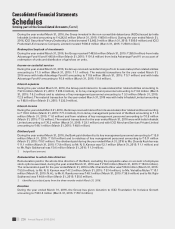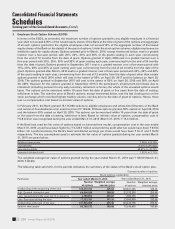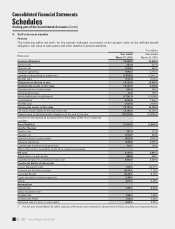ICICI Bank 2016 Annual Report Download - page 224
Download and view the complete annual report
Please find page 224 of the 2016 ICICI Bank annual report below. You can navigate through the pages in the report by either clicking on the pages listed below, or by using the keyword search tool below to find specific information within the annual report.
Annual Report 2015-2016222
Schedules
forming part of the Consolidated Accounts (Contd.)
Consolidated Financial Statements
c) Amounts recovered against debts written-off in earlier years and provisions no longer considered necessary
in the context of the current status of the borrower are recognised in the prot and loss account.
d) The Bank maintains general provision on performing loans and advances in accordance with the RBI
guidelines, including provisions on loans to borrowers having unhedged foreign currency exposure,
provision on exposures to step-down subsidiaries of Indian companies and oating provision taken over from
erstwhile Bank of Rajasthan upon amalgamation. For performing loans and advances in overseas branches,
the general provision is made at higher of host country regulations requirement and RBI requirement.
e) In addition to the provisions required to be held according to the asset classication status, provisions are
held for individual country exposures including indirect country risk (other than for home country exposure).
The countries are categorised into seven risk categories namely insignicant, low, moderately low, moderate,
moderately high, high and very high and provisioning is made on exposures exceeding 180 days on a graded
scale ranging from 0.25% to 25%. For exposures with contractual maturity of less than 180 days, provision is
required to be held at 25% of the rates applicable to exposures exceeding 180 days. The indirect exposure is
reckoned at 50% of the exposure. If the country exposure (net) of the Bank in respect of each country does
not exceed 1% of the total funded assets, no provision is required on such country exposure.
ii) In the case of the Bank’s housing nance subsidiary, loans and other credit facilities are classied as per the
NHB guidelines into performing and non-performing assets. Further, NPAs are classied into sub-standard,
doubtful and loss assets based on criteria stipulated by NHB. Additional provisions are made against specic
non-performing assets over and above what is stated above, if in the opinion of the management, increased
provisions are necessary.
iii) In the case of the Bank’s overseas banking subsidiaries, loans are stated net of allowance for credit losses. Loans
are classied as impaired and impairment losses are incurred only if there is objective evidence of impairment
as a result of one or more events that occurred after the initial recognition on the loan (a loss event) and that loss
event (or events) has an impact on the estimated future cash ows of the loans that can be reliably estimated.
An allowance for impairment losses is maintained at a level that management considers adequate to absorb
identied credit related losses as well as losses that have occurred but have not yet been identied.
The total proportion of loans for which subsidiaries have applied accounting policies different from the Bank as
mentioned above, is approximately 10.22% of the total loans at March 31, 2016.
15. Transfer and servicing of assets
The Bank transfers commercial and consumer loans through securitisation transactions. The transferred loans are
de-recognised and gains/losses are accounted for, only if the Bank surrenders the rights to benets specied in the
underlying securitised loan contract. Recourse and servicing obligations are accounted for net of provisions.
In accordance with the RBI guidelines for securitisation of standard assets, with effect from February 1, 2006, the
Bank accounts for any loss arising from securitisation immediately at the time of sale and the prot/premium arising
from securitisation is amortised over the life of the securities issued or to be issued by the special purpose vehicle to
which the assets are sold. With effect from May 7, 2012, the RBI guidelines require the prot/premium arising from
securitisation to be amortised over the life of the transaction based on the method prescribed in the guidelines.
In the case of loans sold to an asset reconstruction company, the excess provision is not reversed but is utilised to
meet the shortfall/loss on account of sale of other nancial assets to securitisation company (SC)/reconstruction
company (RC) in accordance with RBI guideline dated July 13, 2005. With effect from February 26, 2014, in accordance
with RBI guidelines, in case of non-performing loans sold to SCs/RCs, the Bank reverses the excess provision in prot
and loss account in the year in which amounts are received.
The Canadian subsidiary has entered into securitisation arrangements in respect of its originated and purchased
mortgages. ICICI Bank Canada either retains substantially all the risk and rewards or retains control over these
mortgages, hence these arrangements do not qualify for de-recognition accounting under their local accounting
standards. It continues to recognise the mortgages securitised as “Loans and Advances” and the amounts received
through securitisation are recognised as “Other borrowings”.




